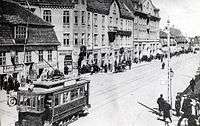Liepājas tramvajs
Liepājas tramvajs is a municipal company that operates a single tram line in Liepāja, Latvia. The current double-tracked tram line has a length of 7.9 kilometres (4.9 mi).[3]
Two KT4 trams in July 2013 | |
| state owned | |
| Industry | transportation |
| Founded | 1899 |
| Headquarters | Liepāja, Latvia |
Key people | Aigars Puks,[1] CEO |
| Revenue | |
Number of employees | 70[2] |
| Website | http://www.liepajas-tramvajs.lv |
History
1899

The first electric tram line in the Baltic states was founded in Liepāja, September 26, 1899. The first nine trams used by the company were made by Herbrand (based in Köln, Germany). The first tram line was built to Karosta.
1903
In 1903 the company ordered six new trams from Herbrand. The new trams received numbers 10 to 16.
1904
Two-way tram line has been built at Liela street in the city center.
1940
After World War II the old Herbrand trams has been placed to new self-made frames. 18 March 1941 for the first time since 1899 the woman (Anna Cekuse) has become the conductor. The company starts to use tree-digit numbering, precessing tram number with 1. In 1949-1956 few trams has been built in Liepāja using the details from Kaliningrad and self-made frames.
1957
In 1957 Liepājas tramvajs has received 8 Gotha T57 trams with numbers 125-132.
1960
Liepāja has received 10 new trams Gotha Т59Е with the numbers 139-148 in 1961. In 1962 has been bought 8 new Tatra T2-62 with numbers 149-156.
1970
In 1974 Liepājas tramvajs has transported 12 million passengers per year.
1990
New tram-stops with add stands has been built in Liepāja by EuroAWK
2007
In Liepāja widely discussed plans to extend the tram line to the Ezerkrasts district. The company starts to offer new service — payments for the tram tickets by mean of SMS. This service was developed in cooperation with Riga company Citycredit.
2013
the tram line to the Ezerkrasts district is made
Fleet
The current fleet consists of 16 Tatra KT4 trams, including type KT4SU trams delivered new to Liepāja, type KT4D trams formerly in service in Cottbus, Gera and Erfurt, Germany and a German tram track cleaner which was built in 1954 and is the only working model left in the world.
Tickets & price
| Year | Price | Currency |
|---|---|---|
| 1900 | 0.02-0.05 | Russian ruble |
| 1933 | 0.10-0.15 | LVL |
| 1946 | 0.20-0.40 | Soviet ruble |
| 1947-1990 | 0.03 | Soviet ruble |
| 1994-2006 | 0.25 | LVL |
| 2007-2011 | 0.30 | LVL |
| 2012 | 0.38-0.50 | LVL |
| 2016 | 0.80 | EUR |
Gallery
 Tram station in Karosta
Tram station in Karosta Tram No. 12 at Peldu St.
Tram No. 12 at Peldu St. Tram No. 13 near Kursaal (Kūrmāja)
Tram No. 13 near Kursaal (Kūrmāja)
References
- "Liepājas tramvajs unofficial site". Retrieved April 1, 2012.
- Ints Grasis (2010). "Tramvajs NAV miris! Lai dzīvo tramvajs!". Liepājas Vēstules Nr. 3 (in Latvian). Kurzemes Vārds. pp. 22–27. Missing or empty
|url=(help) - Mackinger, Gunter (December 31, 2019). "Tram Liepaja in Lettland vor der Modernisierung" [Liepaja tramway in Latvia gets modernized]. Urban Transport Magazine (in German). Archived from the original on February 29, 2020. Retrieved February 29, 2020.
External links
| Wikimedia Commons has media related to Trams in Liepāja. |
- Official website (in Latvian)